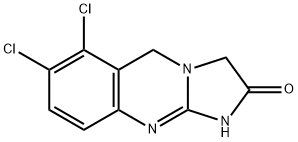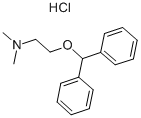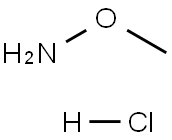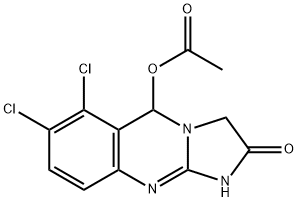Anagrelide hydrochloride
Synonym(s):6,7-Dichloro-1,5-dihydro-imidazo[2,1-b]quinazolin-2(3H)-one hydrochloride
- CAS NO.:58579-51-4
- Empirical Formula: C10H8Cl3N3O
- Molecular Weight: 292.55
- MDL number: MFCD01720337
- EINECS: 680-360-9
- SAFETY DATA SHEET (SDS)
- Update Date: 2025-01-27 09:38:02

What is Anagrelide hydrochloride ?
Description
Anagrelide hydrochloride was launched in the US for thrombocytosis (essential or associated with chronic myelogenous leukemia). The imidazoquinazoline derivative can be prepared from 2,5,6-trichloro-3,4-dihydropyrimidine via alkylation with ethyl bromoacetate followed by heating with ethanolic ammonia or treatment of N-(a-amino- 5,6-dichlorobenzyl)glycine ethyl ester with cyanogen bromide. As a result of its anti-cAMP phosphodiesterase (PDE Ⅲ) activity, Anagrelide hydrochloride was initially tested as a platelet aggregation inhibitor. However it was found that at much lower concentrations it became thrombocytopenic. While the mechanism is not fully understood, it did not shorten platelet survival nor inhibit the formation of colony-forming unitsmegakaryocytes (CFU-M) but primarily interfered with the maturation of megakaryocytes (reduction in size with altered ploidy). It did decrease peripheral vascular resistance and had a positive inotropic effect.
Chemical properties
Off-White Powder
Originator
Roberts (US)
The Uses of Anagrelide hydrochloride
Anagrelide Hydrochloride is a phosphodiesterase inhibitor with antiplatelet activity. Used as an antithrombocythemic. Potent PDE3 inhibitor.
The Uses of Anagrelide hydrochloride
Signal Transduction Agents, Potent PDE3 inhibitor
What are the applications of Application
Anagrelide hydrochloride is a potent type III phosphodiesterase inhibitor
Definition
ChEBI: The hydrochloride salt of anagrelide.
Manufacturing Process
6,7-Dicloro-1,2,3,5-tetrahydroimidazo[2,1-b]quinazolin-2-one was produced
from 6-chloro-7-bromo-1,2,3,5-tetrahydroimidazo[2,1-b]quinozolin-2-one by
substitution the bromine an equimolar quantity chlorine.
6-Chloro-7-bromo-1,2,3,5-tetrahydroimidazo[2,1-b]quinazolin-2-one was
produced next way: to a solution of 1.30 g (8 mmole) of anhydrous ferric
chloride in 30 ml of nitromethane was added 1.30 g (5 mmole) of solid 6-
chloro-1,2,3,5-tetrahydroimidazo[2,1-b]quinazolin-2-one and 0.80 g (5
mmole) of bromine. The system was stoppered, warmed to 50°C in an oil
bath overnight, cooled to room temperature and the solvent removed in
vacuo. The resulting solid was suspended in water (50 ml), the mixture was
made basic (pH=10) with sodium bicarbonate and stirred at home
temperature for 20 min. The solid was filtered under suction, washed with
water, then isopropyl alcohol and dried yielding 1.19 g of 6-chloro-7-bromo-
1,2,3,5-tetrahydroimidazo[2,1-b]quinazolin-2-one (78% yield). Purification
was effected by formation of the hydrochloride salt (mp 275°C) from
acetonitrile.
6-Chloro-1,2,3,5,-tetrahydroimidazo[2,1-b]quinazolin-2-one was produced
from 6-chloro-2-nitrobenzylchloride, ethylglycine hydrochloride and cyanogen
bromide in 3 steps.
brand name
Agrylin (Shire).
Therapeutic Function
Platelet aggregation inhibitor
General Description
Anagrelide belongs to the imidazo[2,1-b]quinazolin-2-one series of compounds.
Biological Activity
Potent type III phosphodiesterase (PDE3) inhibitor (IC 50 = 36 nM). Inhibits platelet aggregation and produces potent thrombocytopenic effects via inhibition of megakaryocyte maturation.
Biochem/physiol Actions
Anagrelide is a phosphodiesterase inhibitor with antiplatelet activity (IC50 = 36 nM for inhibition of phosphodiesterase-III). Anagrelide inhibits the maturation of megakaryocytes into platelets, reducing both megakaryocyte hyperproliferation and differentiation. As a drug, anagrelide is antithrombocythemic used for the treatment of overproduction of blood platelets.
References
1) Gilespie?et al.?(1988),?Anagrelide: a potent and selective inhibitor of platelet cyclic AMP phosphodiesterase enzyme activity; Biochem. Pharmacol.?37?2866 2) Mazur?et al.?(1992),?Analysis of the mechanism of anagrelide-induced thrombocytopenia in humans; Blood,?79?1931 3) Wang?et al.?(2005),?Comparison of the biological activities of anagrelide and its major metabolites in haematopoietic cell cultures; Br. J. Pharmacol.,?146?324 4) Barbui?et al.?(2012),?Front-line therapy in polycythemia vera and essential thrombocythemia; Blood Rev.,?26?205 5) Chen?et al.?(2012),?Platelet-lowering therapy with anagrelide as an adjuvant therapy for treatment of primary pulmonary neoplasm-associated extreme thrombocytosis; Jpn. J. Clin. Oncol.,?42?761
Properties of Anagrelide hydrochloride
| Melting point: | >280°C |
| storage temp. | 2-8°C |
| solubility | DMSO: soluble1mg/mL, clear (warmed) |
| form | powder |
| color | white to beige |
| Stability: | Stable for 1 year from date of purchase as supplied. Solutions in DMSO may be stored at -20°C for up to 3 months. |
| CAS DataBase Reference | 58579-51-4(CAS DataBase Reference) |
Safety information for Anagrelide hydrochloride
| Signal word | Warning |
| Pictogram(s) |
 Health Hazard GHS08 |
| GHS Hazard Statements |
H351:Carcinogenicity H413:Hazardous to the aquatic environment, long-term hazard |
| Precautionary Statement Codes |
P202:Do not handle until all safety precautions have been read and understood. P273:Avoid release to the environment. P280:Wear protective gloves/protective clothing/eye protection/face protection. P308+P313:IF exposed or concerned: Get medical advice/attention. P405:Store locked up. P501:Dispose of contents/container to..… |
Computed Descriptors for Anagrelide hydrochloride
New Products
3-Iodophenylacetic acid 3-Pyridineacetonitrile, α-hydroxy- 2-Propanamine, 1-chloro-, hydrochloride (9CI) 3-(hexyloxy)-4-(pyridin-3-yl)-1,2,5-thiadiazole 2-Hexyn-1-ol Dibenzo-18-crown-6 Nickel(II) perchlorate hexahydrate, 98% 4-Bromophenylacetonitrile, 95% 3-Bromo-4-fluoroaniline, 97% Sodium tetraborate decahydrate, 98% Palladium(II) acetate, trimer, Pd 99% 4-Bromo-2-chlorotoluene, 97% N N Dimethylformamide Dimethyl Acetal (Dmf Dma) 2,3-Dichloro Benzoyl Cyanide [Side Chain] Bis(2-Chloroethyl) Amine Hydrochloride L-Glutamic Acid Diethyl Ester Hydrochloride 5-(Difluoromethoxy)-2-Mercaptobenzimidazole 1-Ethyl-3-(3-Dimethylaminopropyl)-Carbodiimide Hydrochloride [EDC Hcl] 1,4-Napthoquinone Bromoiodomethane Sodium Bicarbonate Methylene Dichloride (MDC) Ethyl Acetate Indole-3-Carbinol (I3C)Related products of tetrahydrofuran








You may like
-
 58579-51-4 Anagrelide hydrochloride 98%View Details
58579-51-4 Anagrelide hydrochloride 98%View Details
58579-51-4 -
 Anagrelide hydrochloride CAS 58579-51-4View Details
Anagrelide hydrochloride CAS 58579-51-4View Details
58579-51-4 -
 17604-74-9 3-Pyridineacetonitrile, α-hydroxy- 98+View Details
17604-74-9 3-Pyridineacetonitrile, α-hydroxy- 98+View Details
17604-74-9 -
 131987-69-4 98+View Details
131987-69-4 98+View Details
131987-69-4 -
 Cyclohexane, (2-propynyloxy)- 67967-07-1 98+View Details
Cyclohexane, (2-propynyloxy)- 67967-07-1 98+View Details
67967-07-1 -
 2-Propanamine, 1-chloro-, hydrochloride (9CI) 98+View Details
2-Propanamine, 1-chloro-, hydrochloride (9CI) 98+View Details
5968-21-8 -
 3-Iodophenylacetic acid 1878-69-9 98+View Details
3-Iodophenylacetic acid 1878-69-9 98+View Details
1878-69-9 -
 132945-75-6 (S)-1-Boc-3-methanesulfonyloxy-pyrrolidine 98+View Details
132945-75-6 (S)-1-Boc-3-methanesulfonyloxy-pyrrolidine 98+View Details
132945-75-6
